

Isaac Moillon (8 July 1614, Paris - 26 May 1673, Paris) was a French Baroque painter of scenes from mythology and the Bible. He also designed tapestries. His work was forgotten after his death, until interest was revived in the 1980s.


Isaac Moillon (8 July 1614, Paris - 26 May 1673, Paris) was a French Baroque painter of scenes from mythology and the Bible. He also designed tapestries. His work was forgotten after his death, until interest was revived in the 1980s.
His father, the painter Nicolas Moillon (1555-1619), died when he was only five years old. Shortly after, his mother married another painter, François Garnier , who specialized in still-lifes. His sister, Louise Moillon, would become one of the best known still-life painters of that period. Despite the intense religious situation at that time, both he and his sister remained Protestants.
His first works date from 1634 to 1637. Between 1638 and 1640, he created decorations, mostly of a military nature, in the Hôtel Bautru, an hôtel particulier, under the direction of its architect, Louis Le Vau and the Master Builder Michel Villedo, in the Rue Croix-des-Petits-Champs. It was demolished in 1823 to make way for the new Galerie Vivienne. [1] His fame at the time rested largely on murals depicting Christ as a healer, made at the Hôtel-Dieu de Beaune (now the Hospices de Beaune) in 1646. He was named a member of the Académie royale de peinture et de sculpture in 1655.
As a painter to the King, he created several designs for tapestries, including a few on the history of Achilles, that were woven at the Aubusson manufactory. [2] Some are kept at the Hospices de Beaune, along with miniatures depicting scenes from the life of Christ. A series on Ulysses may be seen at the Château de Villemonteix . The Cité internationale de la tapisserie in Aubusson has nine pieces on Dido and Aeneas. Seven on the "Illustrious Women of Antiquity" are at the Château d'Ansouis in Vaucluse.

Jacint Rigau-Ros i Serra, known in French as Hyacinthe Rigaud, was a Catalan-French baroque painter most famous for his portraits of Louis XIV and other members of the French nobility.

Aubusson is a commune in the Creuse department region in central France.

Charles Le Brun was a French painter, physiognomist, art theorist, and a director of several art schools of his time. He served as a court painter to Louis XIV, who declared him "the greatest French artist of all time". Le Brun was a dominant figure in 17th-century French art and was influenced by Nicolas Poussin.
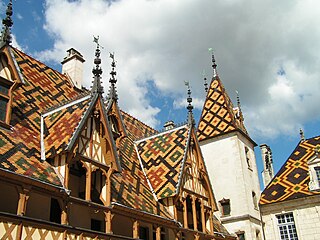
Beaune is the wine capital of Burgundy in the Côte d'Or department in eastern France. It is located between Lyon and Dijon. Beaune is one of the key wine centers in France, and the center of Burgundy wine production and business. The annual wine auction of the Hospices de Beaune is the primary wine auction in France.

Simon Vouet was a French painter who studied and rose to prominence in Italy before being summoned by Louis XIII to serve as Premier peintre du Roi in France. He and his studio of artists created religious and mythological paintings, portraits, frescoes, tapestries, and massive decorative schemes for the king and for wealthy patrons, including Richelieu. During this time, "Vouet was indisputably the leading artist in Paris," and was immensely influential in introducing the Italian Baroque style of painting to France. He was also according to Pierre Rosenberg, "without doubt one of the outstanding seventeenth-century draughtsmen, equal to Annibale Carracci and Lanfranco."

Jean-Baptiste Madou was a Belgian painter and lithographer.

Pieter Boel or Peeter Boel was a Flemish painter, printmaker and tapestry designer. He specialised in lavish still lifes and animal paintings. He moved to Paris, where he worked in the gobelin factory and became a painter to the king. Pieter Boel revolutionized animal painting by working directly from live animals in a natural setting. He thus arrived at representations of animals showing them in their natural, characteristic poses. He had many followers in France.

Charles-Joseph Natoire was a French painter in the Rococo manner, a pupil of François Lemoyne and director of the French Academy in Rome, 1751–1775. Considered during his lifetime the equal of François Boucher, he played a prominent role in the artistic life of France.
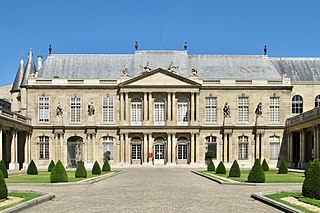
An hôtel particulier is a grand townhouse, comparable to the British townhouse or mansion. Whereas an ordinary maison (house) was built as part of a row, sharing party walls with the houses on either side and directly fronting on a street, an hôtel particulier was often free-standing and, by the 18th century, would always be located entre cour et jardin – between the cour d'honneur and the garden behind. There are hôtels particuliers in many large cities in France.

Claude Lefèbvre was a French painter and engraver.

Aubusson tapestry is tapestry manufactured at Aubusson, in the upper valley of the Creuse in central France. The term often covers similar products made in the nearby town of Felletin, whose products are often treated as "Aubusson". The industry probably developed soon after 1300 with looms in family workshops, perhaps already run by the Flemings who were noted in documents from the 16th century.

The Hospices de Beaune or Hôtel-Dieu de Beaune is a former charitable almshouse in Beaune, France. It was founded in 1443 by Nicolas Rolin, chancellor of Burgundy, as a hospital for the poor. The original hospital building, the Hôtel-Dieu, one of the finest examples of fifteenth-century Burgundian architecture, is now a museum. Services for patients are now provided in modern hospital buildings.
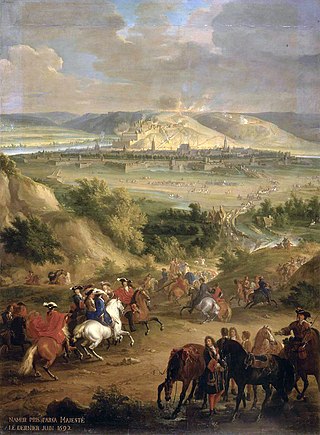
Jean-Baptiste Martin, known as "Martin des Batailles" was a French painter, decorator and designer who specialized in drawings for tapestries. He was best known for battle scenes, hence his nickname.

Guigone de Salins (1403–1470) was a member of the nobility in the state of Burgundy in late medieval France. A well-known philanthropist in her time, she founded the Hospices de Beaune in 1443 with her husband Nicolas Rolin, chancellor to the Duke of Burgundy.
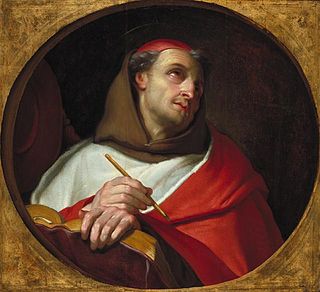
Claude François was a French painter and Recollect Franciscan friar. He is better known as Frère Luc, the name he adopted after becoming a monk.

The Louis XIV style or Louis Quatorze, also called French classicism, was the style of architecture and decorative arts intended to glorify King Louis XIV and his reign. It featured majesty, harmony and regularity. It became the official style during the reign of Louis XIV (1643–1715), imposed upon artists by the newly established Académie royale de peinture et de sculpture and the Académie royale d'architecture. It had an important influence upon the architecture of other European monarchs, from Frederick the Great of Prussia to Peter the Great of Russia. Major architects of the period included François Mansart, Jules Hardouin Mansart, Robert de Cotte, Pierre Le Muet, Claude Perrault, and Louis Le Vau. Major monuments included the Palace of Versailles, the Grand Trianon at Versailles, and the Church of Les Invalides (1675–1691).

Charles-Caius Renoux was a French painter, lithographer, and illustrator. He first achieved success with paintings of medieval churches, particularly the ruins of cloisters and monasteries destroyed during the French Revolution, works for which he is still best known. Renoux also painted landscapes, large-scale battle scenes, and historical subjects, works which uniquely prepared him for the final phase of his career, the creation of spectacular dioramas, the "moving pictures" of the era. He also taught at the École des Beaux-Arts in Paris; his notable students included Narcisse Berchère and Hector Hanoteau.
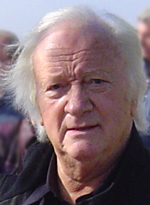
Michel Degand was a French painter, sculptor, cartoonist, and graphic artist.
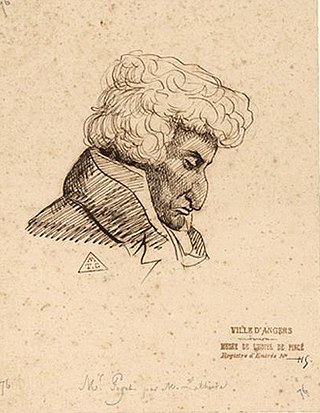
Bernard Poyet was a French architect, best known for his work on the Palais Bourbon in Paris.

Jean Chastellain (1490–1541) was a master glassmaker of the French Renaissance.